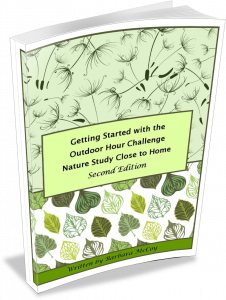March 1, 2008
Dear Nature Friends,
Today we took our Outdoor Hour Challenge on the road, or should I say trail? The last Friday of every month we take the day off from our regular schooling to have a Nature Day. This is something I have been doing all year with my 12 and 14 year old sons. We take the day and focus on some aspect of nature that fits in with our science lessons or our interests.
Please remember when you read my post and view my photos (and a short video) that we have been doing nature study in our family since these two boys were able to walk….a long time. We also live in a moderate climate and have limitless access to wilderness. This hike is literally out our door and a few miles away. On a scale of one to ten, this day was a perfect ten. I hope that puts our experience in perspective for you beginners. This is what your nature study can look like in a few years if you keep at it, little by little.
In challenge number 1 I shared our hike on a new trail…the one with the ferns and the unusual bud. We wanted to take the hike all the way to the river this time so after a short stop at our tree in the woods, we headed over to the trail head. We set off at a quick pace but soon we found wildflowers blooming and of course I had to stop to take a few photos.
Buttercup
I wasn’t able to identify this one yet, need to see it flowering.
We saw our first butterflies of the season, big brown ones and little blue ones. The sun was actually hot and we shed a layer of sweaters and sweatshirts…good thing I had my backpack on this hike. 🙂 We had good conversation as we hiked along. Oh, we saw what the “unusual looking bloom” was from our last trip. It is actually just the way the leaves pop out on this particular plant.

It was a long downhill hike to get to the river, I think about a mile and a half but the hard part is that it was a really steep downhill grade. I kept thinking about the hike back up with great dread. Would the hike be worth it we kept asking?
The minute we hit the edge of the river and I was shedding my pack, the boys excitedly called to me to come over and look at something. I could tell it was something good by the tone in their voices. Wow! A whole pool of California newts!
We spent quite a bit of time watching them in their courtship dance in the crystal clear water. Fascinating and we felt so grateful to have seen it. My youngest slipped into the water with one foot and had a soaking shoe, sock, and pant leg for the rest of the hike. After a few photos and a video, we all sat at the edge of the river and rested and listened and just soaked it all in.
Yes, you can train your children to sit quietly and listen.
The boys were soon doing their usual river thing…throwing in rocks. I sat and worked in my nature journal drawing the blackberry leaves and vine next to me. The boys found a little gold flake in the gravel at the edge of the river. We actually live near where the California Gold Rush started on this very river.
I need to make a note to put a little vial for collecting things in my backpack. This flake was dropped into the rocks and was never seen again. He wants to go back and try again some time.
But the highlight of the day happened right when we were packing up to go back up the trail…..yes, you haven’t seen the highlight yet. The boys spotted a frog that had just jumped out of the water onto a rock. Back out comes the camera to try to get a photo for their nature journals.
While getting a few good photos, two of the frogs started croaking. Their throats blew up like balloons and the sound of it was awesome. Would you like to hear? [If you are on email subscription you will need to come over the the blog to see the video..I think.]There are actually two frogs croaking in the video and they croak at about 25 seconds and 50 seconds into the video. When we got home we pulled out our field guide and identified this as a Pacific Treefrog.
My YouTube video of a Pacific Treefrog.
Both boys wanted to do their journals on the newt.
I got a new scanner but I have not learned how to operate it very well yet…maybe next scan will be better.
Thanks for sharing our very exciting “day out” with us. Hope it inspired and encouraged you in to have some of your own adventures with nature study. Our family looks forward to each time we have to share time out of doors. The answer to the question earlier about whether the hike would be worth the effort? Yes, totally and completely. I would go again right now….sore muscles and all.
One last photo of my son and I kneeling over the water trying to see the frogs.




































